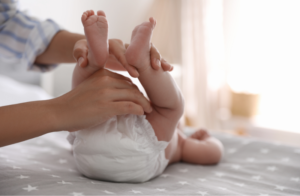Wet Diapers and Baby Poop – What You Can Expect
 You will be amazed at the number of diapers your baby can use in a day! Your baby’s diet affects the colour and frequency of your baby’s pee and poop.
You will be amazed at the number of diapers your baby can use in a day! Your baby’s diet affects the colour and frequency of your baby’s pee and poop.
What does baby poop look like? (click to expand) »
Meconium is your baby’s first poop. It is thick greenish black and sticky.
It changes from thick, greenish black to green in the first few days, then to yellow or yellowish brown by the end of the first week.
Breastfed babies have more yellow poop, and it may look seedy. Their poop can be runny or pasty. Formula-fed babies tend to have poop that becomes yellow, then closer to tan and sometimes a shade of green. Formula-fed babies often have firmer bowel movements.
What does baby pee look like? (click to expand) »
Babies can have orange spots or crystals in the diaper. This is normal during the first few days after birth. Baby’s pee will be pale yellow. How much you baby pees will change over the first few days.
Day 1: 1 wet diaper
Day 2: 2 wet diapers
Day 3: 3 wet diapers
Day 4: 4 wet diapers
Days 5-7: 5 wet diapers
After 7 days: 6 wet diapers
(Reference: Health Canada, May 2023)
It is difficult to know if disposable diapers are wet or not. To know what a wet diaper feels like, pour two to four tablespoons of water in a dry diaper and feel the weight of it. You can also place a tissue in the diaper, and you will see when it is wet. Check out this video to see a diaper change.
When do I need to see my health care provider? (click to expand) »
See your health-care provider if your baby:
- suddenly has fewer wet diapers and seems sick or isn’t feeding well;
- has not peed in 24 hours;
- has orange crystals in their diaper and are more than 3 days old;
- passes hard or pellet like poop and has trouble passing poop;
- has black poop after the first few days;
- has red, grey or white or beige poop;
- has blood in their diaper; or
- has diarrhea, watery or explosive poop and seems unwell. This may be difficult to judge in some breastfed babies.
Signs that your baby is growing (click to expand) »
Parents are often concerned about the number of wet diapers and poops their baby. This can be a sign of how much milk they are getting.
However, it is important to remember there are other positive signs that a baby is growing and developing. These include:
- Baby is content after most feedings.
- Breasts feel less firm after feeding.
- Baby is swallowing at the breast.
- Baby is bright and alert.
- Baby feels heavier and is filling out clothes.
- Baby is gaining weight.
There is a lot to learn about caring for a newborn. Reach out and ask as many questions as you need to feel comfortable. Trust that you know your baby best.
Services related to this information:
- Contact your Public Health Nurse.
- Breastfeeding support
- 811 HealthLine (Newfoundland & Labrador) – Call 811 or 1-888-709-2929 / TTY 1-888-709-3555.

